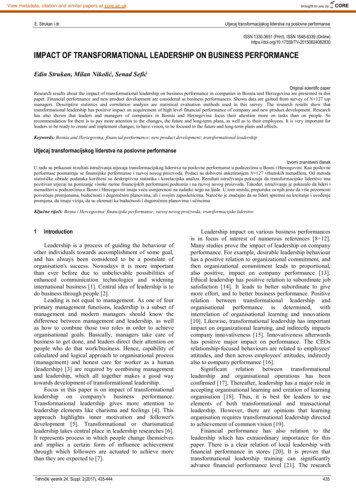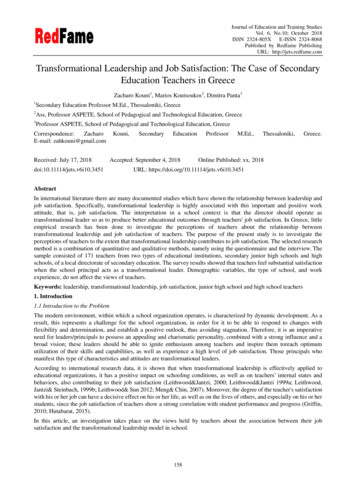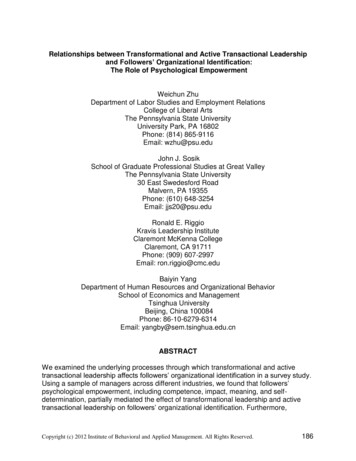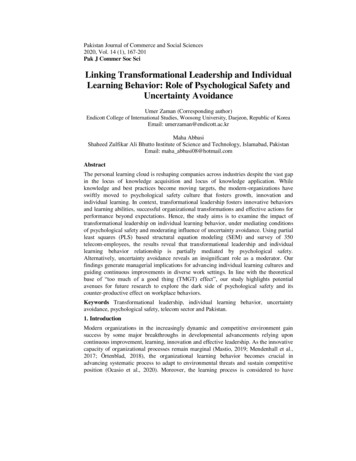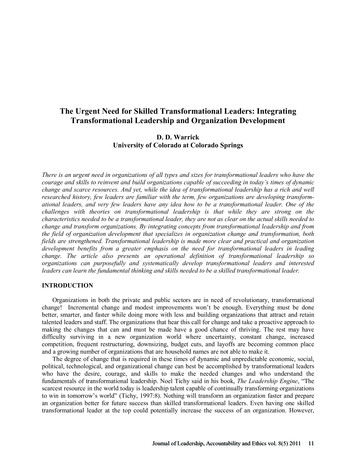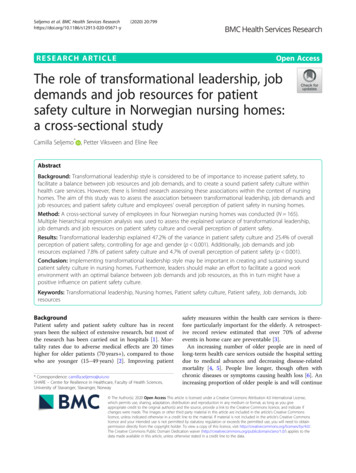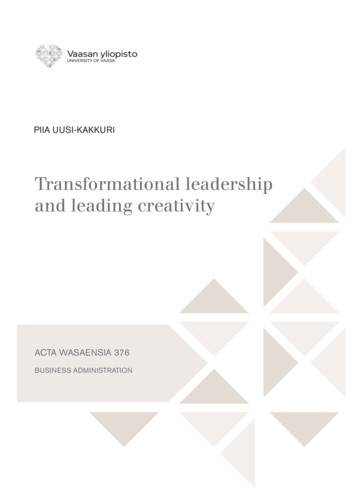
Transcription
PIIA UUSI-KAKKURITransformational leadershipand leading creativityACTA WASAENSIA 376BUSINESS ADMINISTRATION
ACADEMIC DISSERTATIONTo be presented, with the permission of the Board of the Faculty of BusinessStudies of the University of Vaasa, for public dissertationin Auditorium Kurtén (C203) on the 4th of August, 2017, at 1 p.m.ReviewersProfessor Vesa PuhakkaUniversity of Oulu, Oulu Business School, Department ofManagement and International BusinessP.O.Box 8000,FI-90014 UNIVERSITY OF OULUFinlandProfessor Iiris AaltioUniversity of Jyväskylä, School of Business and Economics,Department of Management and LeadershipP.O.Box 35,FI-40014 UNIVERSITY OF JYVÄSKYLÄFinland
IIIJulkaisijaVaasan yliopistoTekijä(t)Piia Uusi-KakkuriYhteystiedotVaasan yliopistoKauppatieteellinen tiedekuntaJohtamisen yksikköPL 700FI-65101 VAASAJulkaisupäivämääräElokuu 2017Julkaisun tyyppiArtikkeliväitöskirjaJulkaisusarjan nimi, osan numeroActa Wasaensia, 376ISBN978-952-476-748-4 (painettu)978-952-476-749-1 (verkkoaineisto)ISSN0355-2667 (Acta Wasaensia 376,painettu)2323-9123 (Acta Wasaensia 376,verkkojulkaisu)SivumääräKieli2 3englantiJulkaisun nimikeTransformationaalinen johtajuus ja luovuuden johtaminenTiivistelmäVäitöskirja tutkii transformationaalisen johtajuuden soveltuvuutta luovienja innovatiivisten ihmisten johtamisessa. Asiaa tarkastellaan kahdestanäkökulmasta. Ensin tutkitaan asiaa alaisten näkökulmasta. Millaistajohtajuutta innovaattorit haluavat ja ovatko jotkut transformationaalisenjohtajuuden ulottuvuuksista arvokkaampia heille kuin toiset. Lisäksitarkastellaan, miten hyvin suomalaisten johtajien johtajuuskäyttäytyminen sopii innovaattoreiden odotuksiin. Toiseksi tarkastellaan transformationaalisen johtajuuden ja luovuuden ennustavia tekijöitä,keskittyen erityisesti persoonallisuuteen. Näitä näkökulmia tutkittiinseitsemän artikkelin kautta.Tulokset vahvistavat, että myös luovien ja innovatiivisten alaistennäkökulmasta transformationaalinen johtajuus on suositeltava johtamistyyli. Erityisesti älyllinen stimulointi eli yllyttäminen ja inspiroiva motivointi ovat tärkeitä innovatiivisten ihmisten johtamisessa. Älyllinenyllyttäminen on transformationaalisen johtajuuden ulottuvuus, jossamyös suomalaisten johtajien olisi kehityttävä.Transformationaalisimmat johtajat ovat myös luovia ja heillä onerinomaiset lähtökohdat johtaa innovaattoreita. Tuloksia voidaanhyödyntää, kun haetaan johtajaa, joka osaa johtaa luovia ihmisiä sekäedistää organisaation luovuutta tukevaa kulttuuria.AsiasanatTransformationaalinen johtajuus, luova johtajuus, luovuuden johtaminen,luovuus, innovatiivisuus, innovaattorit, älyllinen yllyttäminen, älyllinenstimulointi, persoonallisuus, persoonallisuustyyppi
VPublisherVaasan yliopistoAuthor(s)Piia Uusi-KakkuriContact informationUniversity of VaasaFaculty of Business StudiesDepartment of ManagementP.O. Box 700FI-65101 VaasaFinlandDate of publicationAugust 2017Type of publicationDoctoral thesis by publicationName and number of seriesActa Wasaensia, 376ISBN978-952-476-748-4 (print)978-952-476-749-1 (online)ISSN0355-2667 (Acta Wasaensia 376, print)2323-9123 (Acta Wasaensia 376, online)Number of pages Language2 3EnglishTitle of publicationTransformational leadership and leading creativityAbstractThe purpose of this dissertation is to determine the appropriateness oftransformational leadership in leading creative and innovative individuals.This is investigated from two perspectives. First is an examination offollowers’ leadership preferences to determine whether innovators, forexample, may prefer transformational leadership to other styles, and if sothen which sub-dimensions are important. It is also considered whetherthe actual behaviors of leaders in Finland correspond with these findings.Second is a comparison of the antecedents, particularly personality, oftransformational leadership and creativity to determine if there is a fit.These questions are investigated through seven articles.The results indicate that transformational leadership is an appropriatestyle for the leadership of creative people. In particular, intellectualstimulation and inspirational motivation should be applied when leadingcreative individuals and innovators. However, intellectual stimulation isan area of leadership that would benefit from development amongstleaders. In addition, the most transformational leaders are creative aswell, which indicates that they are in good position to lead innovators.The results can be used in identifying the most transformational andcreative individuals to increase the variety of personalities amongstleaders, especially when innovation is called for.KeywordsTransformational leadership, creative leadership, creativity,innovativeness, innovators, intellectual stimulation, personality,personality type
VIIACKNOWLEDGEMENTI have learned so much about myself and the multiple ways to kick myselfforward when the going got tough during this process. I am so proud of theoutcome but it would have not happened without the support that I have receivedfrom the people around me. The process was hard at times, but it was neverlonely and the best moments were with my supervisors who are talentedacademics and creative individuals.I have always loved learning, but I would have not taken on this extensivelearning journey if my supervisor Professor Vesa Routamaa hadn’t first hired meas a research assistant during my undergraduate studies and later asked tocontribute as part of the Personality approach to leadership and organizationalstudies research team. Thank you for the trust, wise perspectives on personalitydifferences and the strengths that lie within us, not to mention the fun stories!My other supervisor, AssRFLDWH Professor and docent Tiina Brandt, is the perfectexample of a transformational leader who should be around to lead people likeme! Leading by example, never judging or belittling my suggestions that were farfrom complete, constantly developing new ideas with a flare of fun! Givingfreedom, and not pressuring, yet also challenging me to improve and figurethings out! All of this with the humbleness and willingness to exchange feedback.Thank you for this journey Tiina, I cannot imagine it without you and ourfriendship!I started my bachelor’s studies in 2008, and started working at the department in2009. During those years, I enjoyed so many great conversations and laughs andshared ideas, common frustrations, and support with the wonderful people atwork. You made this crazy process enjoyable! Thank you to my coffee roomregulars and friends. Mireka Harju, your positivity, friendliness, andthoroughness is very inspiring. Susanna Kultalahti, working with you was alwayssuch a breeze and we have shared so many great moments together; your quickwit and imitations skills makes everyone’s day. Anni Rajala, your determinationcombined with great sense of humor and caring is delightful. Kati Saarenpää,your empathy and news flashes saved many situations. I was so happy to haveyou to fight the final battles with me.I also had many others over the years whose collaboration and support makes mevery grateful. Thank you for everything Associate professors Annika Tidström,Olivier Wurtz, and Doctors Karita Luokkanen-Rabetino, Narashima Boopathi,Jenni Kantola and Phd. candidate colleagues Hilpi Kangas, Rumy Narayan,
VIIISanna Skyttälä, Suvi Einola, Sniazhana Sniazhko, and Shaghayegh Ghaffaripour.I also have had a pleasure of collaborating with people outside of our unit: Thankyou for the collaboration Doctor Pia Hautamäki, Doctor Krista Jaakson, BerndtPape and Pia-Liisa Äijö. Finally, a special thank you to Associate professor NiinaKoivunen, who was always ready to discuss and help with academic issues as wellas life in general.Multiple foundations have supported this topic and my working during the years,I am very grateful to Evald and Hilda Nissi Foundation, the Jenni and AnttiWihuri Foundation, and the Foundation for Economic Education. Mydepartment heads and the Dean also made it possible for me to complete thisdissertation by employing me as a Doctoral candidate, enabling me to developalso as a lecturer and instructor. Thank you to Professors Marko Kohtamäki,Adam Smale, Vesa Suutari, and Riitta Viitala.Pre-examiners, professors Vesa Puhakka and Iiris Aaltio, helped to improve mydissertation through insightful comments. Thank you so much for your time andeffort! I also want to thank Nathan Schwartzman, whose efficient proofingimproved the language of this dissertation greatly. Thank you to Tiina Jokinenfor helping me with so many practical things over the years and to Merja Kalliofor finalizing the layouts.I am also very grateful for my family, who have always supported me during thisjourney! I do not know what I would do without my mother, Tarja Uusi-Kakkuri,whose selfless love and caring could not be replaced. My father, Matti UusiKakkuri, has always emphasized the meaning of education and setting goals. Iappreciate your interest and the level of thoughtfulness and honesty of ourconversations. Toni Uusi-Kakkuri, your fun yet caring spirit always makes me sohappy to have a “little” brother like you, please know I am always here for you!Markku Ojala, despite that one same old joke, I’m forever grateful to have you inour lives, as well as the sweetest “siblings” Mira and Jyri Ojala, Anni Siltala andMiia Uusi-Kakkuri one could ask for. Lee Smith, the laughs and moments weshared so far are out of this world and I also want to thank the rest of mydaughter’s family in Pennsylvania for their support and love. Finally, to mywarm-hearted grandmother, Marjatta Nevala, I love talking with you of all thingshappening now and in the past. You have given me so many great memories!Thank you for being in my life, I love you all!I am lucky to have gained new family members. Isabel Haapalainen, you are assweet as you are fast in your moves, I hope you stay curious in life. BenjaminHaapalainen, I value your insights and our conversations from everything frompolitics to sports. Love you both! To Salme, Pekka, Mari, Timo, and Tiina
IXHaapalainen, thank you for accepting me into your lives. Our two-year-oldgodson Noel Haapalainen has been a reminder of what is important in life withhis unsurpassable presence, smile, and wit. As has our Aldo, who took me out forwalks and kept me company at all times with his understanding pup eyes.To my dearest friends from childhood, Anne Kotiranta and Jenni Kuusisto, wehave already gone through so many phases of life together; it would make upanother book. Thank you being part of this phase, too. Your friendship,understanding, and mental health get-togethers in the past, present, and futuremean the world to me! Cheers to you my loves!To Teppo Haapalainen, my Luke Danes, it has been an exhausting but excitingand fun ride! We built a house whilst still fitting our families together and meworking on this. Luckily, we are both a bit crazy and creative NFPs; we made itwork; two big projects are now completed! Your intelligence, insights (andcooking!), our conversations and adventurous trips off road in the dessert, deepin the woods, up in the mountains, on ice, on water, by Netflix, and on the dancefloor have made me happy and helped me to leave the majority of work at work!Thank you for your honesty, support, and love during these years. I love you andI cannot wait to keep on trekking our path together!Finally, I dedicate this dissertation to my daughter Kristiina Edinger, the light ofmy life, who is the most loving and positive person I have met. Ever since youwere a tiny toddler, it was so obvious what an empathetic, brave, creative, andhumorous person you are. Thank you for your hugs and help on our hecticevenings, thank you for your daily love and laughter. I am so proud and happy tohave daughter like you! You can do anything you put your mind and spirit into,stay true to yourself and keep on dancing. I love you!Piia Uusi-KakkuriVaasa, 7th of May, 2017-A complete lack of exertion or stress may seem desirable, but in fact it results inboredom and stagnation. It is essential that we keep making continuous efforts amidchallenging circumstances, pushing forward with dynamic creativity and breakingthrough all obstacles. That is the way to develop new strength and achieve fresh growth,whether it be in the case of individual or an organization.Daisaku Ikeda
XIContentsACKNOWLEDGEMENT . VII1INTRODUCTION . 11.1 Research gap and research questions . 31.3 The structure of the study . 72 LEADERSHIP, CREATIVITY AND PERSONALITY. 82.1 Transformational leadership . 82.1.1 Earlier studies of transformational leadership . 132.2 Leading creative and innovative individuals . 212.2.1 Qualities and skills of creative and innovativeindividuals . 252.3 Personality, transformational and creative leadership . 282.3.1 Myers-Briggs Type theory . 292.3.2 Personality type as an antecedent to transformationalleadership and creative leadership . 323 METHODOLOGY . 393.1 Philosophical assumptions . 393.2 Research methods . 404 RESULTS . 484.1 Matching of creative and innovative individuals’ leadershippreferences with actual leadership behaviors . 484.2 Matching of transformational antecedents with antecedents ofcreative leadership . 534.3 Transformational leadership in leading creative and innovativeindividuals . 625 DISCUSSION AND CONCLUSIONS . 645.1 Theoretical implications . 645.2 Practical implementations . 675.3 Limitations and future study suggestions . 705.4 Conclusions . 71REFERENCES. igure 6.Overall framework of the dissertation. 6Four paradigms . 40Approach to first sub-question . 48Approach to second sub-question . 53Match of transformational antecedents withantecedents of creative leadership . 61Summary of all the results . 63
XIITablesTable 1.Table 2.Table 3.Table 4.Table 5.Table 6.Table 7.Table 8.Table 9.Table 10.Table 11.Summary of transformational components . 13Summary of creative and innovative people’s characters 28Relationship of personality and transformationalleadership . 35Relationship of personality and creativity . 38Summary of articles’ participants, measures, andanalyses . 46Key results – personality and and preferences oftransformational leadership . 50CEOs and transformational leadership dimensions . 51Strengths and weaknesses in transformational leadershipand communication style of intellectual stimulationleaders . 52Antecedents of transformational leadership . 56Personality as an antecedent of creativity andinnovativeness of entrepreneurial individuals . 58Personality and gender as an antecedent of creativeleadership . 60AbbreviationsMBTIMyers-Briggs type ip Practices InventoryMLQMultifactor leadership questionnaireCEOChief executive officerEIEmotional intelligence
XIIIPART II: ARTICLESThis dissertation is based on seven appended papers that are:[1]Uusi-Kakkuri, P. & T. Brandt (2015), “Preferred leadership behaviors bydifferent personalities”, International Journal of Business andGlobalisation, 15:4, 461-474.[2]Uusi-Kakkuri, P., Brandt, T. & S. Kultalahti (2016), “Transformationalleadership in leading young innovators – a subordinate perspective”,European Journal of Innovation Management, 19:4, 547-567.[3]Brandt, T. & P. Uusi-Kakkuri (2016), “Transformational leadership andcommunication style of Finnish CEOs”, Communication ResearchReports. 30:2, 119-127.[4]Brandt, T. & P. Edinger (2015), “Transformational leadership in teams –The effects of a team leader’s sex and personality”, Gender inManagement: An International Journal, 30:1, 44-68[5]Uusi-Kakkuri, P., Brandt, T., Ghaffaripour, S., & B. Pape (under review),“Do personality and emotional intelligence predict transformationalleadership qualities?”.[6]Routamaa, V., Brandt, T. & P. Uusi-Kakkuri (2016), “Personality ournalofEntrepreneurship and Small Business, 29:1, 133-148.[7]Uusi-Kakkuri, P. (under review), “Creative leaders – Interaction of thepersonality and gender of leaders with their creativity”. Earlier version ofthis paper was presented at the 4th Ashridge International ResearchConference,inBerkhamsted,UK,inJune2015.
1 INTRODUCTIONSocrates led people to think creatively by asking provocative questions thatrequired reconstructing learned things, which produced original ideas. Platoinstead emphasized the enjoyability of learning new things instead of forcing it(Torrance 1965). This is what transformational leaders are doing when theyengage in intellectual stimulation or use modelling to show that creativity isappreciated and not questioned or rejected.The importance of innovation is undeniable for each company and society in theworld. Innovations and the creativity that precedes them are essential for anyorganization’s effectiveness, success, and long-term survival (Amabile, Conti,Coon, Lazenby, & Herron 1996; Anderson, Potoþnik, & Zhou 2014; Woodman,Sawyer, & Griffin 1993; Zhou & Hoever 2014). A company’s innovation canrevitalize it, while the innovation of a competitor can take away the basis of itswhole business in a matter of months. A creative thought may spark a newinspiration for one person that motivates them for that week or year, or be astarting point for a bigger collaboration that leads into innovation that makes adifference for that team, or for the whole planet. Although Schumpeter (1970)argued that only a small fraction of people has the courage to break routines andignore resistance and that the need for these types of personalities will eventuallydiminish due to constant change and economic progress, to this day it isimportant to recognize these innovators. The role of leaders in this is ever asimportant (Amabile, Schatzel, Moneta, & Kramer 2004; Brandt 2011) andsupporting creative individuals is and should be of interest (Denti 2011; Oldham& Cummings 1996).Creativity and innovation are trendy terms in the talks of many organizationalleaders and the company visions, but are these people really walking the talk, orjust talking the talk? Leaders and organizations should embrace complexity,changing environments, and even failures (Poutanen, Soliman, & Ståhle 2016)but in reality when CEOs or leaders are hired they need to prove themselves, andthey get perhaps three years to do that (Toivola 1984). In such a short time, it iseasier to cut costs and increase efficiency than create something totally new.Although CEOs consider creativity to be one the key competences, still thefinancing end gets the final call (Taylor 2012). There is a need for a shift ofattitudes toward creativity and innovation.Contrary to Schumpeter’s view is the claim that creativity can come from for anyindividual no matter their position in the organization or the task they perform
2Acta Wasaensia(Zhou & Hoever 2014). Creativity among employees, and how leaders andorganizations could increase it, has been widely studied (Basu & Green 1997; LeifDenti 2011; Dul, Ceylan, & Jaspers 2011; Elenkov & Manev 2005; Jung, Wu, &Chow 2008; Martinaityte & Sacramento 2013; âNHUODYDM ýHUQH '\VYLN Slåtten & Mehmetoglu 2014; Yuan & Woodman 2010; Zhou & Hoever 2014).Creativity and innovation have been held up as the greatest savior of smalleconomies, but who is able to innovate now and in the future in this demandingenvironment. It has been found that innovativeness is supported by “supervisorsupport, leader member exchange, manager’s creative personality, organizationalculture and climate, level of information sharing, creativity training,organizational policies, job motivators, degree of corporate socialization andcreative time pressure” (Gupta & Banerjee 2016: 172). Based on the earlierfindings (introduced later in section 2.2), it is safe to assume that the leader isone of the key factors in supporting creativity and innovativeness.Leaders usually influence internal factors (the organizational environment andclimate, vision and strategy, technology, tools and techniques) that influenceinnovative performance (Hunter & Cushenbery 2011; Thamhain 2003) to makethe environment as hospitable as possible for idea generation and effectivecollaboration among different kinds of workers (Mumford, Scott, Gaddis, &Strange 2002a). The amount of resources does not inhibit or increase creativity,since it is the leaders’ and subordinates’ creative actions that can make limited orabundant resources work for their benefit (Sonenshein 2014). Managers cancreate this kind of culture (Leavy 2005) and psychological environment (Leonard& Swap 2011), which should increase overall business performance (Kyrgidou &Spyropoulou 2013). Although the contextual factors and organizational cultureare also important antecedents of creativity (Amabile et al. 1996), they will beexcluded from this dissertation, and the focus on the environmental aspects willbe only on transformational leadership behaviors.The ability to manage change and creativity has been said to be one of the keyelements of transformational leadership (Walck 1996), and there are somepositively correlating findings between transformational leadership andorganizational innovativeness (Jung et al. 2003; Khan, Sarwar, Malik, & Ahmad2014; Shin & Zhou 2003) including on the individual level (Gumusluoglu & Ilsev2009a). Transformational leaders are intellectual, innovative, andentrepreneurial: they understand and respond to the needs of society (Burns1978; Tichy & Devanna 1986) or an organization and its people. “Thetransformational leader can move those influenced to transcend their own selfinterest for the good of the group, organization, or country” (Bass 1985: 15). Thenagain, leadership is not tied to the people with formal power on top, as it can
Acta Wasaensia3happen at all levels (Bass & Riggio 2006) and can be learned (Sashkin,Rosenbach, Deal, & Peterson 1992; Tichy & Devanna 1986). Previous studiesshow that both transformational leadership and creativity are related to MyersBriggs personality type (Brandt 2011; Brandt & Laiho 2013; Brown & Reilly2009; Carroll 2010; Gryskiewicz & Tullar 1995; Hautala 2006; Houtz et al. 2003;Lee & Min 2016). Because knowledge of employee personalities can be used tobenefit mutual understanding and effectiveness in organizations (Fleenor 1997;Gallén 2009; Hautamäki 2016; Routamaa & Hautala 2015; Routamaa,Honkonen, Asikainen, & Pollari 1997) this study also focuses on the Myers-Briggspersonality type as an antecedent to creativity and transformational leadership.The Myers-Briggs type indicator (MBTI) is popular in research on organizations,consulting and management, and is one of the psychological “tool[s] forunderstanding managers and the process of management and leadership” (Walck1996: 55).In addition, it has been argued that leaders themselves should be creative inorder to be able to act as role models, to motivate (Mathisen, Einarsen, &Mykletun 2012), to apply unconventional solutions to problems and challenges(Proctor 1991), to promote ideas, and to develop and mentor others (Mumford etal. 2002a). Since transformational leadership and intellectual stimulation (Bass& Riggio 2006; Brandt 2011) have been suggested as important for the leadershipof creative people, it is of interest whether leaders who are transformational arealso creative.1.1 Research gap and research questionsThis dissertation aims to answer a main research question:Is transformational leadership an appropriate style for leadingcreative and innovative individuals?Although many different types of positive effects of transformational leadershiphas been found at the organizational, team, and individual levels (Cummings etal. 2010; Hoyt & Blascovich 2003; Ng 2016; Noruzy, Dalfard, Azhdari, NazariShirkouhi, & Rezazadeh 2013; Wang, Oh, Courtright, & Colbert 2011),subordinates’ leadership preferences vary depending on their personalities(Hautala 2005) or characteristics (Alsabbagh, Hamid, & Khalil 2015). It has beensuggested QGHUVRQ 3RWRþQLN KRu 2014) that innovativeness should betreated as an independent variable, and therefore it is important to investigate
4Acta Wasaensiawhat kind of leadership behaviors individuals with high innovativeness levelswant rather than looking at how leaders can influence subordinates. So far,innovators’ preferences regarding transformational leadership have not beenstudied. Also, more country specific studies are needed since leadership stylesand subordinates preferences depend on culture (House et al. 2004; Pöllänen2008) and the interaction of personality and culture (Routamaa & Pollari 1998).In addition, it has been suggested that the sub-dimensions of transformationalleaders should gain more attention since different antecedents may correlate withdifferent aspects of leadership behaviors (Deinert, Homan, Boer, Voelpel, &Gutermann 2015; van Knippenberg & Sitkin 2013). The effectiveness oftransformational leadership has gained lot of support, but the level of skills ofbehaviors in each sub-dimension is often left without consideration. It has beenfound that intellectual stimulation, inspirational motivation, and individualizedconsideration (Herrmann & Felfe 2014; Hyypiä & Parjanen 2013; Mumford,Scott, Gaddis, & Strange 2002; Ng 2016; Sosik, Kahai, & Avolio 1998) areeffective in increasing creative or innovative behaviors. Yet, no studies have beenmade of how the most creative and innovative individuals experience them ashaving differing levels of importance.Thus, the abovementioned main question is investigated from two angles. Thefirst angle (as presented in the left side of figure 1) was chosen to explore theissue from the subordinates’ perspective because this perspective has beenlargely ignored, and to find relevant information on Finnish leaders focusing ondifferent sub-dimensions of transformational leadership, as doing so has beenrecommended. Both sub-research questions are wider than usual, since thepurpose is to re-examine the included articles from new perspectives, instead ofonly summarizing their main results. The first sub-research question is:Q1) What are creative and innovative subordinates’ transformationalleadership preferences and do the leadership behaviors correspond with theseneeds?This question is investigated through three articles. First, transformationalleadership is investigated from the subordinates’ perspective in the first andsecond articles. Specifically, what kind of TF behaviors do creative and innovativeindividuals prefer? Next, in the third article, actual CEOs are investigated and todetermine how well their transformational leadership abilities correspond withtheir subordinates’ preferences. The first research question determines howsuitable is transformational leadership to lead creative people from thesubordinates’ perspective, while adding information about how effectively thisleadership style is currently used in leading creative people.
Acta Wasaensia5Article 1) Uusi-Kakkuri, P. & T. Brandt (2015), “Preferred leadership behaviors bydifferent personalities”, International Journal of Business and Globalisation,15:4, 461-474.Article 2) Uusi-Kakkuri, P., Brandt, T. & S. Kultalahti (2016), “Transformationalleadership in leading young innovators – a subordinate perspective”, EuropeanJournal of Innovation Management, 19:4, 547-567.Article 3) Brandt, T. & P. Uusi-Kakkuri (2016), “Transformational leadership andcommunication style of Finnish CEOs”, Communication Research Reports. 30:2,119-127.Second, the importance of the creativity of leaders has received discussion (Guo,Gonzales, & Dilley 2016; Mathisen, Einarsen, & Mykletun 2012; Proctor 1991;Brandt 2011). Innovative leaders have been described as comfortable withchange, thorough, persevering (Kanter, 2004), open, driven, energetic,unorthodox, experimenting, self-confident, intelligent, having an ability to thinkoutside the box and generate ideas, being intrinsically motivated,
transformational leadership in leading creative and innovative individuals. This is investigated from two perspectives. First is an examination of followers' leadership preferences to determine whether innovators, for example, may prefer transformational leadership to other styles, and if so then which sub-dimensions are important.

